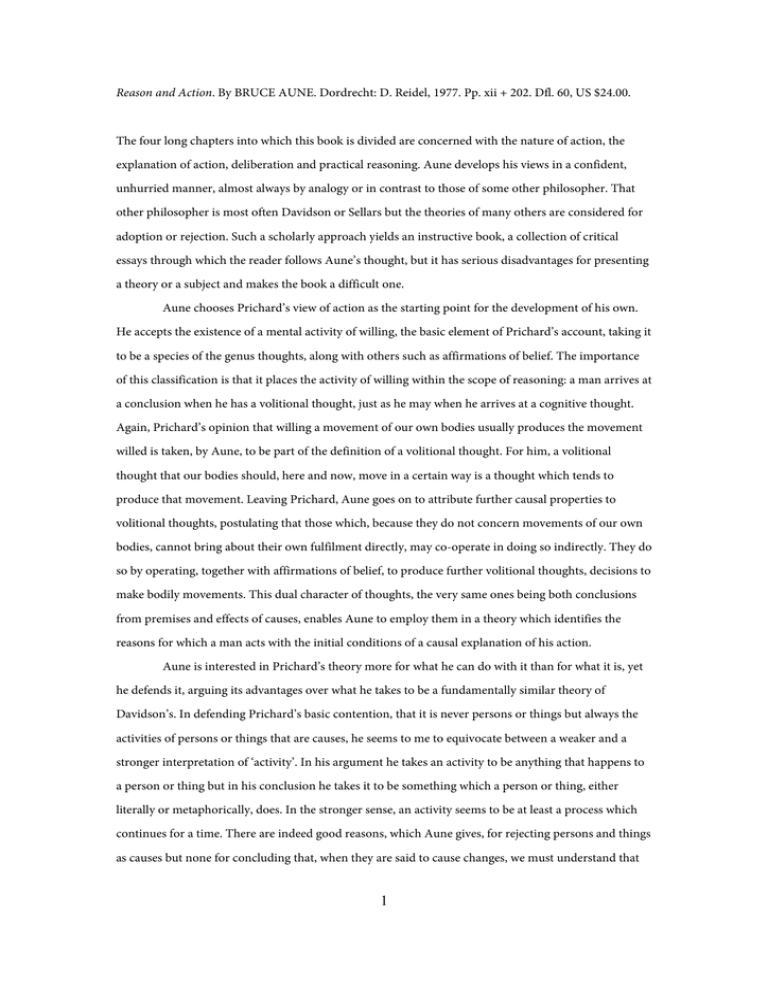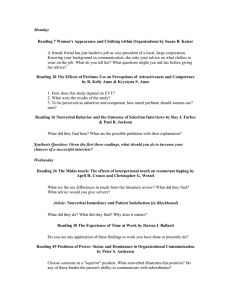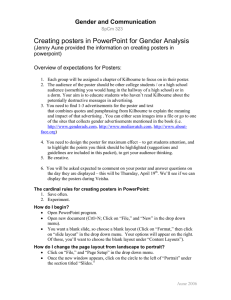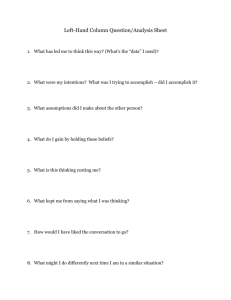Reason and Action
advertisement

Reason and Action. By BRUCE AUNE. Dordrecht: D. Reidel, 1977. Pp. xii + 202. Dfl. 60, US $24.00. The four long chapters into which this book is divided are concerned with the nature of action, the explanation of action, deliberation and practical reasoning. Aune develops his views in a confident, unhurried manner, almost always by analogy or in contrast to those of some other philosopher. That other philosopher is most often Davidson or Sellars but the theories of many others are considered for adoption or rejection. Such a scholarly approach yields an instructive book, a collection of critical essays through which the reader follows Aune’s thought, but it has serious disadvantages for presenting a theory or a subject and makes the book a difficult one. Aune chooses Prichard’s view of action as the starting point for the development of his own. He accepts the existence of a mental activity of willing, the basic element of Prichard’s account, taking it to be a species of the genus thoughts, along with others such as affirmations of belief. The importance of this classification is that it places the activity of willing within the scope of reasoning: a man arrives at a conclusion when he has a volitional thought, just as he may when he arrives at a cognitive thought. Again, Prichard’s opinion that willing a movement of our own bodies usually produces the movement willed is taken, by Aune, to be part of the definition of a volitional thought. For him, a volitional thought that our bodies should, here and now, move in a certain way is a thought which tends to produce that movement. Leaving Prichard, Aune goes on to attribute further causal properties to volitional thoughts, postulating that those which, because they do not concern movements of our own bodies, cannot bring about their own fulfilment directly, may co-operate in doing so indirectly. They do so by operating, together with affirmations of belief, to produce further volitional thoughts, decisions to make bodily movements. This dual character of thoughts, the very same ones being both conclusions from premises and effects of causes, enables Aune to employ them in a theory which identifies the reasons for which a man acts with the initial conditions of a causal explanation of his action. Aune is interested in Prichard’s theory more for what he can do with it than for what it is, yet he defends it, arguing its advantages over what he takes to be a fundamentally similar theory of Davidson’s. In defending Prichard’s basic contention, that it is never persons or things but always the activities of persons or things that are causes, he seems to me to equivocate between a weaker and a stronger interpretation of ‘activity’. In his argument he takes an activity to be anything that happens to a person or thing but in his conclusion he takes it to be something which a person or thing, either literally or metaphorically, does. In the stronger sense, an activity seems to be at least a process which continues for a time. There are indeed good reasons, which Aune gives, for rejecting persons and things as causes but none for concluding that, when they are said to cause changes, we must understand that 1 some activity in which they indulge, or which goes on within them, causes those changes. Prichard held that we must suppose an activity within bodies which produces gravitational attraction, but the fact that we cannot rest content with ‘The sun diverted the comet’ does not mean that we have to attribute the effect to an activity; few things are less like an activity than having mass while occupying a certain position. Aune agrees with Prichard: ‘In this respect the case of John does not differ from that in which we say that an empty car knocked over a lamp post: the car, like the man, must ‘do’ something (in this case, strike the post) for the result to occur’. What does the lamp post ‘do’ to dent the car? Similarly, a man’s actions might have mental causes without those causes being, as Aune assumes, mental activities in which he indulges or which go on for a time in his mind. The weaker position, which Aune speaks of as accepting the reducibility of agent causation to event causation, is held in common between Prichard and Davidson, but there is a reducibility which they do not both accept, that of action to event causation. Davidson takes the actions of people to be reducible to the causal operation of, amongst other things, their desires and beliefs: Prichard takes action to be irreducible. For that reason, Prichard’s view seems to me to be distorted by the analogy Aune draws. There certainly are resemblances. Both recognize basic actions that are the only things people really do, other things people are said to do being the effects of basic actions. Again, they agree over bodily action; both take it to be the production of a bodily movement by something mental, Prichard an activity of willing, Davidson the onset of certain mental states. However, this resemblance is only a point at which two radically different attitudes touch. The main purpose of Prichard’s discussion is to establish what part causation plays in action and, more emphatically, what part it does not play. According to him, causation has no place in the performance of a basic action, so that it is possible for people to act without any causes operating. In Davidson’s basic actions, causation plays an essential role; the two views converge over bodily actions only because these are basic for Davidson but not for Prichard. Misleading or not, it is upon this convergence that Aune focuses: ‘Both affirm that a typical action involves both a mental, volitional component and a physical result’. They disagree only, he considers, in that Prichard identifies the action with the mental component, Davidson with the physical. He finds neither identification satisfactory. Prichard’s has the consequence that what we do can never be observed. Davidson’s does not allow that an action may consist in refraining from a bodily movement, for example, in not moving out of someone’s way. He finds the view that an action is a combination of mental and physical elements no more satisfactory and suggests that the difficulties associated with these identifications arise only upon the assumption that actions exist. We should abandon action theory for agent theory, setting out, I assume, to explain what it is to act, not what 2 actions are. Wishing to reject actions he proceeds to examine Davidson’s arguments for their existence. Romane Clark’s theory of predicate modifiers provides, he suggests, as good an account of adverbs as Davidson’s theory of event predicates without having the consequence that to assert that someone acts is to assert the existence of actions. His rejection of Davidson’s Fregean argument is inconclusive, I think, because he misinterprets its strategy, but he makes a good point about the use of it: if it shows ‘caused it to be the case that’ not to be a sentential connective, it equally shows ‘causally explains the fact that’ not to be one. These discussions are interesting in themselves but I am not convinced of their relevance to the matter in hand. The difficulties he mentions are not great and, if we dispensed with actions, would probably spring up elsewhere. If it is awkward to treat actions as physical movements and awkward to treat them as acts of will, should we jump to the conclusion that there are no such things at all? Aune’s own account of the explanation of action is given in terms of beliefs and intentions. He regards intentions as fundamental to action in ways in which desires are not; when desires influence our actions they can do so only through the formation of intentions, yet a man can act with intention without desiring what he intends. Aune rejects Hume’s view that desires lead to action by being transmitted from what we immediately desire to what would yield that; desires lead us, according to Aune, to form plans with the aim of satisfying those desires, but they need not lead us to desire the things we plan to do. Perhaps he is right about that, but he ought not to be led into regarding intentions as propensities, or pro-attitudes, which can move to action (p. 60). To speak in that way is to admit the need for an element in the explanation of action which intentions and decisions do not provide. His discussion of Hume would be clearer if he did not represent himself as opposing Hume’s view that the reason is inert. That view concerns what moves the will, so that it concerns what moves us to form intentions, make decisions and act. Hume considers two candidates, reason and passion, rejecting reason. Aune offers a third, will itself, arguing that intentions can move us to form other intentions, in fact, that the will moves the will, a notably Humean possibility that Hume neglected. Aune’s advocacy of will displaces passion but does nothing to rescue reason. He does, indeed, try to make it appear to do so by arguing that ‘we are moved to act by reason (by beliefs, thoughts and decisions) as well as by our passions’ (p. 59) but he does not himself suppose that beliefs and thoughts by themselves move to action and the making of decisions was not the part of that reason which Hume declared to be inert. Perhaps the most interesting suggestion in the book is Aune’s proposal for resolving a well known difficulty of the theory that, if having certain reasons causes a man to act, he acts for those reasons. There are counter-examples to that theory in which a man is led by his beliefs and intentions 3 to an action which, nevertheless, is not performed in the belief that it will fulfil those intentions. Aune’s example is of a blow struck to insult one person and happening to frighten another. If the action of striking the one person is the very same as that of frightening the other, then they have the same causes, including the intention to insult the former person, yet the striking is done for that reason and the frightening for no reason at all. Aune argues that beliefs and intentions have causal consequences which arise from personal dispositions of two kinds. A man who accepts the validity of a logical principle will, Aune considers, be so disposed that the formation in him of certain beliefs and intentions will lead him to decisions bearing them a regular logical relationship. Thus, the intention to achieve Q, together with the belief that P is the only means of doing so, will lead a man who accepts the validity of inference of the form ‘Q; if not P, then not Q; therefore, P’ to decide to bring about P. In contrast, a man may have other dispositions according to which the formation of beliefs and intentions disposes him to behaviour which, although regularly related to those beliefs and intentions, bears them no regular logical relationship. When a man’s reasons lead him to a decision to act through a disposition for his beliefs and intentions to develop in accordance with logical rules, his action is performed for those reasons. When they lead him to an action through dispositions of other sorts, or, as in Aune’s example of the blow and the frightening, through other causal regularities, it is not. This theory has promise, but cannot, I think, be correct as it stands. The fact that a person subscribes to a logical principle tells us nothing about the way his beliefs and intentions will develop, except that there are some combinations which he will not come to hold. It does not do so since it does not tell us whether, having seen what he takes to be the consequences of a decision, he will accept it or renounce it. Again, the knowledge that a man accepts the laws of negation does not inform us that he will never believe something one minute but its negation the next. Subscription to a logical principle implies no regular development of a person’s behaviour, so that the distinction Aune relies upon does not exist. The discussion of practical inference in the third chapter is an eminently sensible one; it proceeds, in part, by criticism of von Wright and Anthony Kenny. Aune argues, as against von Wright’s earlier views, that only a premise expressing an intention can imply a practical conclusion; one expressing a desire cannot do so. It does not, indeed, seem inconsistent to desire what we are convinced we cannot obtain, whereas it does seem so to intend to do what we are convinced we cannot do. Aune’s view of practical logic is the opposite of Kenny’s. Kenny, following Aristotle, holds that one decision follows from another if its fulfilment implies that of the other. Aune considers it not inconsistent to stand by one decision yet reject another which would fulfil it. On the other hand, he holds it 4 inconsistent to stand by one decision and reject another, without the fulfilment of which it itself cannot be fulfilled. However, Aune accepts that the invalid form I will bring about E, If I do A, I shall bring about E, Therefore, I will do A, has a place in everyone’s deliberation. He suggests that the premises serve to bring the performance of A before their minds as something which, because it is a means of attaining E, deserves their consideration. When Aune develops his own theory of practical inference in the fourth chapter, again by his critical approach, examining theories of Sellars, Binkley and Castafleda, he is led into strange paths. The theory which leads him is that the logic of practical inference is exactly that of assertoric inference: ‘the volitional “will” is logically indistinguishable from the “shall” of mere futurity.’ He starts sensibly enough by accepting that the aim of practical logic is to discover what must be done if our ends are to be realised. Perhaps that is not the aim of practical logic, but it is certainly a main consideration when the validity of a practical inference is in question. Now, a plan can be assessed by employing ordinary logic to discover the consequences of adopting it and, in that consideration, we may invoke anything that would hold if the plan were adopted. We cannot discredit a plan by invoking facts which would not have been facts if the plan had been adopted. Suppose that all sorts of dreadful things are about to follow the failure to build a Thames barrage next year; it hardly needs saying that those disasters could not be employed to discredit the plan to build the barrage. Yet, in Aune’s practical logic, they could be. They are facts. Any facts can be taken together with the indicative supposition that the plan is adopted to yield consequences which can, on his principle, be regarded as unacceptable decisions proved on the supposition that the plan is to be adopted. In fact, Aune explicitly accepts the validity of such inferences as: P shall be, P materially implies Q, Therefore, Q shall be. He does not fail to notice the paradox of doing so; indeed, he points out that, if such inferences are valid, the premises that P shall be and that P will not be together imply that every possibility shall 5 be. With perfect consistency he takes this to be a proof that ‘P shall be’ contradicts ‘P will not be’. That a plan cannot be carried out does discredit it; how can the fact that it will not be carried out do so? I am sorry not to give a fuller consideration of Aune’s defence of his logic. It has, evidently, the logician’s virtues of simplicity and economy. This book has very many other interesting discussions which I have been unable to consider. I recommend it strongly. 6







